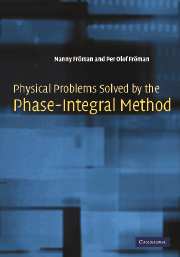Preface
Published online by Cambridge University Press: 13 August 2009
Summary
Only a few quantal problems are exactly soluble by analytical methods. In practice one has almost always to resort to an appropriate approximation method or to numerical integration of the Schrödinger equation. Among the great variety of approximate methods used in quantum mechanics, one may discern three different main types: perturbation methods, variational methods and asymptotic methods. The topic of the present book falls into this last category.
The merit of an asymptotic treatment is that it not only provides a convenient means for approximate calculation of details, but often it also has a fundamental physical significance. In our present context, the asymptotic treatment of the Schrödinger equation yields in its zeroth order the classical Hamilton–Jacobi equation, in its first order it yields the semi-classical approximation and in its higher orders it yields, in many important situations, a full account of quantal details, the physical quantities being sometimes obtained with an accuracy hardly obtainable by any other means.
The phase-integral method for the solution of physical problems used in this book is the result of a systematic work by the present authors and their coworkers over about four decades. The book is written with physical needs in mind. It contains three chapters. In Chapter 1, we give a historical survey. The purpose of Chapter 2 is to introduce the reader to the phase-integral method. The form of the wave function is discussed in Section 2.1, and the phase-integral approximation generated from an unspecified base function is presented in Section 2.2.
- Type
- Chapter
- Information
- Physical Problems Solved by the Phase-Integral Method , pp. xi - xivPublisher: Cambridge University PressPrint publication year: 2002

